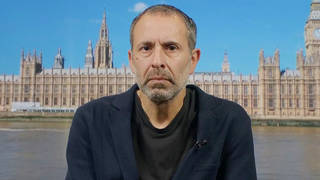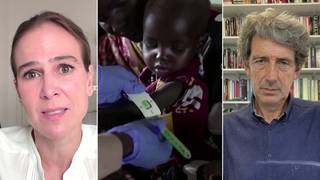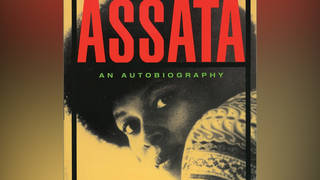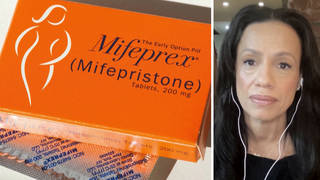
Guests
- Ina May Gaskinthe founder and director of the Farm Midwifery Center in Tennessee. She is the winner of the 2011 Right Livelihood Award. She is the author of Ina May’s Guide to Childbirth and, most recently, Birth Matters: A Midwife’s Manifesta. She is also the founder of the Safe Motherhood Quilt Project, which seeks to draw public attention to the high maternal mortality rate in the United States.
As the controversy over women’s access to contraception continues, we look at women’s access to safe, affordable and comfortable birthing options. Pioneering midwife Ina May Gaskin is the founder and director of the Farm Midwifery Center in Tennessee. Last year, she won a Right Livelihood Award “for her whole-life’s work teaching and advocating safe, woman-centered childbirth methods that best promote the physical and mental health of mother and child.” She is the author of “Ina May’s Guide to Childbirth” and, most recently, “Birth Matters: A Midwife’s Manifesta.” “Insurance has incredible power now, power that it didn’t have 70 years ago. It’s the reason that doctors aren’t learning to do breech deliveries anymore. It’s one of the huge reasons that we have very few midwives in this country,” Gaskin says. “Midwives are at the bottom of the pile, basically, on getting coverage.” Gaskin is also the founder of the Safe Motherhood Quilt Project, which seeks to draw public attention to the high maternal mortality rate in the United States. [includes rush transcript]
Transcript
AMY GOODMAN: We turn now to the latest in the contraceptive controversy that is growing in states around the country. In Arizona, a bill nearing passage in the legislature would allow any employer to opt out of providing contraceptive insurance coverage. Women wishing to get reimbursed could be required to prove that they are taking birth control for a medical reason rather than to prevent pregnancy. In Georgia, the state senate has voted to ban abortion coverage under the state employees’ healthcare plan and prevent employees of private religious institutions from demanding contraceptive coverage under their insurance. The New Hampshire State House has passed a similar measure. And in Utah, lawmakers have passed legislation that would make their state the first to ban public schools from teaching contraception as a way to prevent pregnancy or sexually transmitted disease.
Meanwhile, the industry website radio-info.com reports there is a new list of 31 advertisers who have, quote, “requested [that] their commercials not be scheduled in any Rush Limbaugh programs.” This new list adds to 98 other advertisers who pulled their ads from Rush Limbaugh’s radio show following his use of the terms “slut” and “prostitute” to describe a Georgetown University law student who had advocated for coverage of birth control. At least two stations have completely dropped the Rush Limbaugh program.
Well, as the contraceptive controversy continues, we want to look at another issue involving women’s control over their own bodies and reproductive well-being: the choice of safe, affordable, comfortable birthing options. We are joined right now by Ina May Gaskin, a pioneering midwife, the founder and director of the Farm Midwifery Center in Tennessee. Last year, she won a Right Livelihood Award, quote, “for her whole-life’s work teaching and advocating safe, woman-centered childbirth methods that best promote the physical and mental health of mother and child.” She is the author of Ina May’s Guide to Childbirth and, most recently, Birth Matters: A Midwife’s Manifesta. She is also the founder of the Safe Motherhood Quilt Project, which seeks to draw public attention to the high maternal mortality rate in the United States.
Ina May Gaskin, welcome, up from Tennessee here in New York, to Democracy Now! It’s great to have you with us.
INA MAY GASKIN: Thank you, Amy. It’s great to be here.
AMY GOODMAN: You have brought in a quilt. This is a quilt of young women. It’s sort of like the AIDS quilt?
INA MAY GASKIN: Very much. It was inspired by that, because I knew I had a very difficult story to tell that was going to make people sad and, you know, at the risk of feeling sort of hopeless about it. But we don’t count maternal death. We’ve let so many maternal deaths go invisible in these United States. And at the same—I got my information from the Centers for Disease Control itself. And sort of like I.F. Stone digging out of curiosity, I found this really shocking fact that maybe as much as more than half to two-thirds of the maternal deaths that take place aren’t reported to the CDC. You know, that’s very shocking, because, you know, in most industrialized countries, there’s a huge effort to identify every single maternal death, so that you can say, “OK, how do we reduce it next year?”
AMY GOODMAN: How does the rate of maternal mortality in this country compare to other industrialized countries?
INA MAY GASKIN: Depending on whether you’re looking at World Health Organization data or The Lancet's recent study that was funded by the Gates Foundation, we are 40th or 50th, OK? Now, if you add in the underreporting factor, we have no way of knowing how much farther down list we go, but we're following—you know, we’re behind Czech Republic, we’re behind Poland, we’re behind Bosnia-Herzegovina, we’re behind Slovakia, we’re—the list goes on.
AMY GOODMAN: How? How is that possible?
INA MAY GASKIN: Because we don’t give feedback. We don’t have feedback to our obstetricians, to our hospitals or maternity wards, to find out what we’re doing wrong and why the United States is one of four countries in the world where the maternal death rate is going up, not down.
AMY GOODMAN: What do you make of the whole contraceptive controversy? I mean, you’re a midwife. You’re all about giving birth.
INA MAY GASKIN: Yeah.
AMY GOODMAN: But that’s in a larger context of reproductive rights.
INA MAY GASKIN: That’s right. Well, it’s a human rights issue, as, you know, we’re hearing so clearly brought out, you know, by this furor over what Sandra Fluke had to say. Bless her heart and her bravery in speaking up so well. So, it’s quite clear there that, you know, to women across the country, we need choice. What we’re finding out we don’t have is choice in—when the pregnancy continues. Now what? Where you have the baby, it’s not just a matter of getting the baby out of the woman, it’s how we do it. And so, as our C-section rate goes up, up, up—when I began as a midwife, it was under 5 percent. Now—and then, in only a decade, it had quadrupled. And now we’re, in many hospitals, over 50 percent. And that’s going to mean that you—you’ve lost the benefits now of the C-section, and you’re starting to have women dying because of C-sections.
AMY GOODMAN: Well, explain that.
INA MAY GASKIN: Well, this is—when you do too much surgery, when you enter the abdominal cavity, you know, you’ve introduced whole new kinds of complications that can take place. You can have women dying from pulmonary embolism, and that can happen hours or during a C-section. It can happen after. It can happen after the woman goes home. It can be days or weeks. And there can be just—boom, because she doesn’t know that a pain in her leg is a sign of danger. You can have scar tissue that grows and can cause a bowel obstruction, causing a death that way. You can have a scalpel slip and cut the uteran artery and bleed to death. You can have the bowel knicked and then have an infection set up that might mean an early death from bowel obstruction.
All of these are represented on this quilt. So it’s become a educational device for me to know what the dangers are. And the fact that California reported a tripling of the maternal death rate between 1996 and 2006 should—and the fact that here in New York, the New York Academy of Medicine reported that the death rate, which according to the Health and Human Services should be no higher than three to four per 100,000 births, for African-American women has reached an astounding 79 per 100,000. Should be three or four. And this crosses income categories in the—
AMY GOODMAN: Ina May Gaskin, where do midwives fit into this story, and what is a midwife?
INA MAY GASKIN: That’s a great question. A midwife is a woman who—this is a profession that’s the most ancient for women, OK? It precedes the other one that’s, you know, reputed to be the oldest profession. It certainly preceded medicine. But about five centuries ago, the medical profession, which was just becoming a profession, actually took the first steps of encroaching on this previously women-held territory and then really absorbed midwifery. And that extreme—it went to the greatest extreme here in the United States, where the whole profession was obliterated a century ago.
And what happens in a society when that happens is you have women and practitioners, meaning doctors, and then our case here, nurses, become more and more afraid of birth, because they may never have seen a normal one, and so what becomes a kind of behavior that gets obliterated and made invisible. So, we have—we went to having huge numbers of forceps births. And when I had my first baby, I was pretty much moved into a channel, because I went to a hospital, as everybody did. Little did I know that two-thirds of women in this United States had forceps deliveries in the mid-’60s.
AMY GOODMAN: Meaning they put forceps—
INA MAY GASKIN: Big metal tongs, they put it inside the woman, and they pull the baby out, rather forcibly. And being, you know, the fact that I had a master’s degree in English, I knew this wasn’t a good idea. And I had another piece of my upbringing, which was Dad was a farmer, and I knew that all these animals could give birth, and no forceps, and this didn’t make sense to me. I thought, how could medicine have gotten so crazy to think that…
So then I was part of the '60s eruption, where suddenly it was like it rained overnight and then all these midwives cropped up. And I was one of them. And I got a little instruction from some kind-hearted obstetrician and general practitioner along the way. And counting from the first birth I ever saw, bringing my friends into it to be my midwives for my next births, we were able to safely achieve a statistic that I think people would find incredible: we didn't need a C-section until we got to almost 200 births. And we didn’t endanger anybody in the process.
So we learned how to do—deal with breech deliveries, with twins. And our doctor, the local general practitioner, who had extended his medical education by taking care of Amish people, learned that home birth wasn’t dangerous and that we were much like the Amish. And he helped us and taught us these skills that are—I never knew would be disappearing. So now, you know, 40 years after I got into this, we’re living in a time where it’s rare for me to meet a U.S. doctor who’s allowed to do breech deliveries or twins. At the same time, I have women on this quilt who died for lack of doctors knowing these skills. And I’m watching this dry up in different countries, because a lot of countries are under the impression that we are the country to imitate in birth, when we are absolutely not the country to imitate when it comes to birth. We should be looking at countries where fewer women die.
AMY GOODMAN: How many midwives are there in the United States? Are midwives covered by insurance? What are the laws?
INA MAY GASKIN: Oh, different in every state. But generally, midwives are marginalized. Fewer than maybe 10,000—10 percent of women are able to have a midwife. And in many of these situations, midwives are working with restrictions placed on them, so that they’re often not able to learn even the traditional skills that are associated with midwifery. So, you have midwives taking care of too many women at a time, for instance, and that’s not the same as having your own midwife, or in our care, where you’re probably going to have two midwives with you, because it makes births sweeter to do it that way.
So, we are having now this—with the evaporating skills, it’s come to the point where we’re even having some women who aren’t pregnant who have undergone C-sections, because—yes, just published my article in Birth Journal about a phenomenon that few people know about, but I learned about early from reading it in the obstetrics book that there’s such a thing as a false pregnancy that can even trick the body into mimicking signs of pregnancy when it’s not. And if you don’t put your hands on the woman and feel well, you can miss the fact that there’s no baby in there. And this can progress to a point where she gets cut open, and we go, “Oh, she wasn’t pregnant.” It’s no longer in the obstetrics book.
AMY GOODMAN: We’re talking to Ina May Gaskin. She has a new book out; it is called Birth Matters: A Midwife’s Manifesta. You refer to “we.” Can you talk about where you work and live, the farm in Tennessee?
INA MAY GASKIN: Oh, yeah. Well, we’re blessed to live on 1,750 acres of Tennessee woodland. So it’s a forest. We built a whole community there starting in 1971. And—
AMY GOODMAN: How many people live there?
INA MAY GASKIN: Now we’re about maybe 150 people, but when we settled we were around 300. And my husband Stephen became the first recipient of the Right Livelihood Award, you know, for the work we did, because in learning to build that community, we developed skills that were helpful, and so we had a world outreach, you know, organization we called Plenty. And we did work in Guatemala after an earthquake, and we did work in Lesotho and with Native Americans. And that’s ongoing. So, we lived there. We were vegetarian, had our babies at home, ran a free ambulance service here in the Bronx starting in the late '70s. And so, we're just all over the place doing these sort of different things, and the community is 40 years old now.
AMY GOODMAN: And on the issue of insurance covering midwifery?
INA MAY GASKIN: OK. Insurance has incredible power now, power that it didn’t have 70 years ago. It’s the reason that doctors aren’t learning to do breech deliveries anymore. It’s the reason that midwives are—it’s one of the huge reasons that we have very few midwives in this country. We need 120,000 more easily.
AMY GOODMAN: We have 20 seconds.
INA MAY GASKIN: And so, you don’t have—midwives are at the bottom of the pile, basically, on getting coverage, and especially if we work at home. We’re—we’ve become the scapegoat for all of this distraction, you know? And so, we need payment. We need a lot more midwives. And we also need postpartum care, which midwives could be giving.
AMY GOODMAN: We’re going to continue this interview after the show, and we’ll post it on our website at democracynow.org. Ina May Gaskin is our guest. Her book is Birth Matters: A Midwife’s Manifesta. She’ll be speaking at the 92nd Street Y tonight.












Media Options